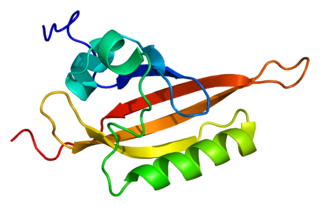
A basic helix–loop–helix (bHLH) is a protein structural motif that characterizes one of the largest families of dimerizing transcription factors.

The ARNT gene encodes the aryl hydrocarbon receptor nuclear translocator protein that forms a complex with ligand-bound aryl hydrocarbon receptor (AhR), and is required for receptor function. The encoded protein has also been identified as the beta subunit of a heterodimeric transcription factor, hypoxia-inducible factor 1 (HIF1). A t(1;12)(q21;p13) translocation, which results in a TEL-ARNT fusion protein, is associated with acute myeloblastic leukemia. Three alternatively spliced variants encoding different isoforms have been described for this gene.

Myogenin, is a transcriptional activator encoded by the MYOG gene. Myogenin is a muscle-specific basic-helix-loop-helix (bHLH) transcription factor involved in the coordination of skeletal muscle development or myogenesis and repair. Myogenin is a member of the MyoD family of transcription factors, which also includes MyoD, Myf5, and MRF4.

Transcription factor 4 (TCF-4) also known as immunoglobulin transcription factor 2 (ITF-2) is a protein that in humans is encoded by the TCF4 gene located on chromosome 18q21.2.

Transcription factor 3, also known as TCF3, is a protein that in humans is encoded by the TCF3 gene. TCF3 has been shown to directly enhance Hes1 expression.

DNA-binding protein inhibitor ID-2 is a protein that in humans is encoded by the ID2 gene.

Neurogenic differentiation 1 (NeuroD1), also called β2, is a transcription factor of the NeuroD-type. It is encoded by the human gene NEUROD1.

DNA-binding protein inhibitor ID-1 is a protein that in humans is encoded by the ID1 gene.

Upstream stimulatory factor 1 is a protein that in humans is encoded by the USF1 gene.

DNA-binding protein inhibitor ID-3 is a protein that in humans is encoded by the ID3 gene.

ID4 is a protein coding gene. In humans, it encodes for the protein known as DNA-binding protein inhibitor ID-4. This protein is known to be involved in the regulation of many cellular processes during both prenatal development and tumorigenesis. This is inclusive of embryonic cellular growth, senescence, cellular differentiation, apoptosis, and as an oncogene in angiogenesis.

ETS domain-containing protein Elk-3 is a protein that in humans is encoded by the ELK3 gene.

Transcription factor 21 (TCF21), also known as pod-1, capsuling, or epicardin, is a protein that in humans is encoded by the TCF21 gene on chromosome 6. It is ubiquitously expressed in many tissues and cell types and highly significantly expressed in lung and placenta. TCF21 is crucial for the development of a number of cell types during embryogenesis of the heart, lung, kidney, and spleen. TCF21 is also deregulated in several types of cancers, and thus known to function as a tumor suppressor. The TCF21 gene also contains one of 27 SNPs associated with increased risk of coronary artery disease.

Protein lyl-1 is a protein that in humans is encoded by the LYL1 gene.

Aryl hydrocarbon receptor nuclear translocator 2 is a protein that in humans is encoded by the ARNT2 gene.

Transcription factor AP-4 , also known as TFAP4, is a protein which in humans is encoded by the TFAP4 gene.

Twist-related protein 2 is a protein that in humans is encoded by the TWIST2 gene. The protein encoded by this gene is a basic helix-loop-helix (bHLH) transcription factor and shares similarity with another bHLH transcription factor, TWIST1. bHLH transcription factors have been implicated in cell lineage determination and differentiation. It is thought that during osteoblast development, this protein may inhibit osteoblast maturation and maintain cells in a preosteoblast phenotype.

Hairy/enhancer-of-split related with YRPW motif-like protein is a protein that in humans is encoded by the HEYL gene.

Helix-loop-helix protein 1 is a protein that in humans is encoded by the NHLH1 gene.

Myogenic factor 6 is a protein that in humans is encoded by the MYF6 gene. This gene is also known in the biomedical literature as MRF4 and herculin. MYF6 is a myogenic regulatory factor (MRF) involved in the process known as myogenesis.
















